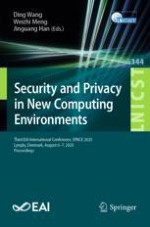2021 | Book
Security and Privacy in New Computing Environments
Third EAI International Conference, SPNCE 2020, Lyngby, Denmark, August 6-7, 2020, Proceedings
Editors: Ding Wang, Dr. Weizhi Meng, Jinguang Han
Publisher: Springer International Publishing
Book Series : Lecture Notes of the Institute for Computer Sciences, Social Informatics and Telecommunications Engineering
